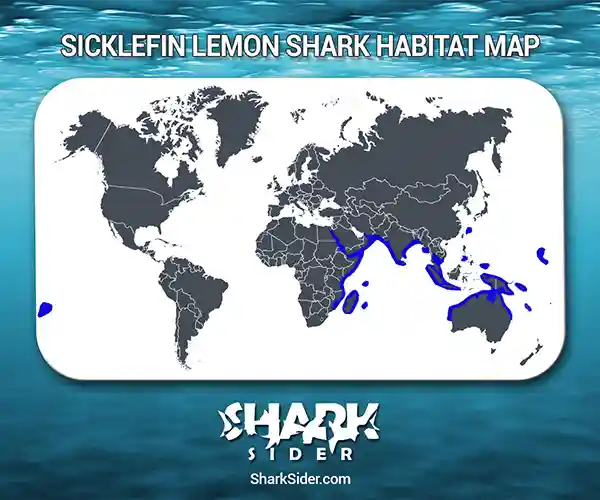Sicklefin lemon sharks are stout-bodies sharks found in the Indo-Pacific tropical oceanic waters. Also called the sharptooth lemon shark, the broadfin shark, Indian lemon shark, Indo-Pacific lemon shark, or just sharptooth shark; the species was moved to the genus Negaprion in 1940 by Australian ichthyologist Gilbert Percy Whitley.
They were first described in a publication titled- Fishes of the Red Sea by German naturalist Eduard Rüppell in 1837. The first type specimen was a 2.23 feet long individual caught in the Red Sea off Jeddah, Saudi Arabia.

Sicklefin Lemon Shark Scientific Classification |
|
| Kingdom | Animalia |
| Phylum | Chordata |
| Class | Chondrichthyes |
| Order | Carcharhiniformes |
| Family | Carcharhinidae |
| Genus | Negaprion |
| Scientific Name | Negaprion acutidens |
Description
They are 10 feet long on an average, capable of reaching a maximum length of 12 feet.
The upper side of their body has a grayish or pale yellow tint which transitions into a lighter underside.
They have a small but broad head ending in a wedge-shaped snout. The head consists of tiny nostrils covered with triangular skin flaps and a set of small eyes. There is presence of short furrows at the edge of the mouth which comprise an average of 14 tooth rows on both jaws and tiny teeth in the midline of the jaw (symphysis).
The upper teeth consist of a solo narrow cusp flanked by a notch on either side; the teeth are angled at the mouth corners. The lower teeth closely resemble the upper teeth in shape, though appear more erect and narrower.
Adult sicklefin lemon sharks over 4.6 feet long have finely serrated teeth.
These sharks have sickle-shaped dorsal, pectoral, and pelvic fins. Near the pelvic fins lies the positioning site of the first dorsal fin. The second dorsal fin, similar in size to the first dorsal fin, is located right in front of the anal fin. The pectoral fin of an increased length and breadth originates below the gap between the third and fourth gill slits.
These sharks have overlapping dermal denticles consisting of 3-5 horizontal ridges.
Where do they live
Map Of The Sicklefin Lemon Shark’s Habitat

They have an extensive distribution extending from South Africa up to the Red Sea, covering the islands of Madagascar, Mauritius, and Seychelles. They extend eastwards towards the Indian subcontinent, moving up to Southeast Asia. One could even spot them northwards along the Philippines and China. Down south, the sicklefin lemon shark dwells in Northern Australia and New Guinea. In the Pacific Islands, one could spot them along the Marshall Islands, Fiji, French Polynesia, New Caledonia, Solomon Islands, and Vanuatu.
Most of these sharks live in waters less than a depth of 9.2 ft. in a diverse habitat including coral reefs, estuaries, and mangroves.
One individual was spotted venturing into open water near the carcass of a sperm whale. These sharks have also been known to swim into waters so shallow that their dorsal fins are exposed. Juvenile sicklefin lemon sharks found in the nurseries of Herald Bright (Western Australia), reside in the waters surrounding the mangroves and open areas with a depth below 9.8 ft.
Behavior
Dietary
The sicklefin lemon shark mostly feeds on bottom and shore dwelling ray-finned fishes like – sea catfish, mackerel, silversides, needlefish, herrings, mullets, porgies, triggerfish, parrotfish, and porcupinefish. There have been a few instances where these sharks feed on cephalopods, crustaceans and sometimes stingrays and guitarfish (as preferred by some older individuals.
Reproductive
They follow a viviparous mode of reproduction where a placental connection (which develops after four months of gestation) formed from the depleted yolk sacs of the mother sustains the developing embryos.
Gestation period lasts 10-11 months after which the female can give birth to 1-13 pups with the general litter size containing 6-12 pups. Each pup measures 18–31 inches at the time of birth. There is little evidence pointing out the philopatric nature of these sharks i.e. for reproduction, they return to the site where they were born.
At Madagascar and Aldabra, these sharks give birth in October or November whereas in French Polynesia, they give birth in January which is also the time when ovulation and mating for non-pregnant females occurs.
Both male and females sharks attain sexual maturity when they are 7.2-7.9 feet long after growing slowly at a rate of 4.9-6.1 inches every year.
Adaptations
Like most sharks, the sicklefin lemon sharks depend on bluestreak cleaner wrasses to clean off parasites on their body surface or mouths. There have been documented records of the shark keeping its mouth open for up to 150 seconds to allow the wrasses access to their mouth.
Interactions with humans
The sicklefin lemon shark is commercially important in several nations for its meat, liver oil, and fins. Its meat is edible, either sold fresh or dried and salted. The liver oil is used for vitamins, while the fins go into the preparation of shark fin soup.
Although shy and non-aggressive when approached by divers, precautions must be taken when encountering the shark, as there have been several records of them acting out aggressively and attacking humans when provoked. Their large size and sharp teeth pose a considerable threat to humans.
Overfishing and local extinctions in countries like Thailand and India makes this shark a vulnerable species. They have a selective habitat preference which when destroyed (coral reefs destruction by cyanide poisoning, destruction of mangroves), poses a threat to their already declining numbers.
The IUCN has listed the sicklefin lemon shark as ”Endangered”. There are no conservation methods currently underway to protect and conserve these sharks. In Australia, these sharks have been assessed as Least Concern since they are caught as a bycatch here only in small numbers.
